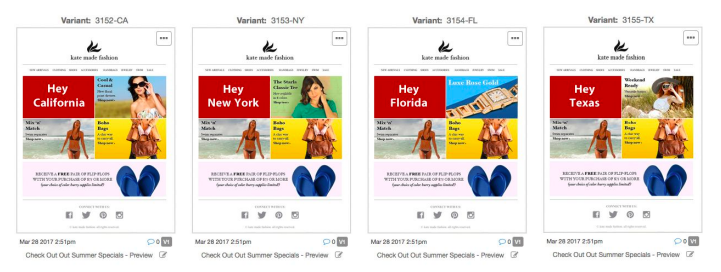
Proofing Dynamic Content with ProofJump
The one-size-fits-all method of email marketing – where the same static message is sent to every recipient – doesn’t work anymore. Email marketing has gotten very sophisticated in recent years, and now, personalizing messages with dynamic content is crucial to developing effective email campaigns.
In simplest terms, dynamic content is any content in an email message that automatically changes based on the data you have for each recipient. This data could be demographic (e.g., location or age), behavioral (messages they’ve opened in the past or products they’ve purchased), or psychographic (personal preferences such as blogs they read or movies they like).
Dynamic content works because it’s based on conditional logic, so each message you send to a subscriber list is personalized to the specific person who receives it. Once you set it up, everything happens automatically.
However, proofing dynamic content in email campaigns can be confusing for reviewers. Imagine sending 10-20 versions of your email campaign to stakeholders that include multiple combinations of personalized dynamic content to proof and approve! Getting feedback on campaigns with multiple variants can quickly become a time-consuming, error prone, and confusing process.
For example, if you proof emails in inboxes, you need to send every dynamic content variant to each stakeholder for review. The image below shows how confusing this can become when the first four variants of a campaign are sent for review.

Things get significantly more difficult when there are more variants and when you send revised versions of each variant. Stakeholders’ inboxes will skyrocket from four to 24 or more messages, which they’ll have to sift through and make sense of. Mistakes will happen, delays are inevitable, and your email review and approval system will fail.
Fortunately, there is a better solution. With ProofJump, you send the copies of your email to ProofJump and all of the variants are automatically labeled, version controlled, and displayed visually in a single page as shown below.

To start the proofing process, you just need to send your stakeholders a single link. They click on that one link and can view all variants, comments, versions, and so on in a single place. No more costly inbox clutter, confusion, mistakes, or delays!
Dynamic Content Proofing: Ad Hoc and Auto-Label
There are two options for proofing content with ProofJump – ad hoc and auto-label. Let’s take a closer look at each one.
Ad Hoc Proofing
With ad hoc proofing, you create a campaign in ProofJump and send all variants of the campaign from your email service provider (ESP) to the campaign’s unique email address provided specifically for your campaign.
You then share the campaign link with your stakeholders. It’s extremely easy for everyone. The downside with the ad hoc method is that you have to reivse each proof separately as new versions are updated.
Auto-Label Proofing (ALP)
Automated Label Proofing is ProofJump’s super power. You’ll never review dynamic content without ProofJump once you try it.
Dynamic Content Identifiers as Labels
The secret behind automated labels is tagging your test emails with one or more dynamic content identifiers. An identifier can be a segment id, a customer attribute (gender, region, preference), or the seed list recipient email address (assuming you’ve set up a seed list with each record mapped to a unique segment in your campaign).
For example, let’s say you own a pet store, and you frequently send campaigns with personalized offers targeting three kinds of customers: dog lovers, cat lovers and other pet lovers. In addition, you already have a seed or test list that looks like the table below in a Data Extension (Salesforce Marketing Cloud). If you use another ESP, the concepts should roughly be the same although the syntax may differ.

In the above table, you can either use the “email” or “pet_type” field as the unique identifier. For this example, let’s use “pet_type”.
You have two options to insert the identifier into your test emails so ProofJump can automatically process and display the labels in the campaign overview.
1.Subject
Add the identifier as a dynamic content value (i.e., AMP Script variable) in the test subject line with this format [v:]
[v:%% pet_type %%] This is a test subject
([v:dog] This is a test subject)
2. Meta tag
Place the following meta tag in the of your email.
<meta name = “cw_variant” content = %%pet_type%%”>
Send a test with all the different variants from your ESP to the unique email address that is provided when you create a new campaign in ProofJump. Once ProofJump receives your message, the emails will be auto labelled with a variant identifier.
Share the campaign link with stakeholders, and they’ll be able to annotate and review all the variants on one page as shown in the image below.

Automatic Versioning
With Auto-Label Proofing, when you send updates from your ESP, ProofJump will automatically create a new version of the proofs based on the identifier – no more confusion and clutter.
Key Takeaways about Proofing Dynamic Content with ProofJump
Dynamic content is essential to optimize email marketing results because it allows you to automatically personalize campaigns for every recipient. Research repeatedly shows that personalization improves open rates, click rates, and conversions, and with ProofJump in your marketing toolbox, leveraging dynamic content to boost performance is no longer a time-consuming, risky investment.
Go ahead and give ProofJump a try! If you have any questions, please don’t hesitate to reach out to hello@proofjump.com.
